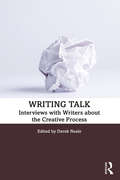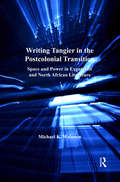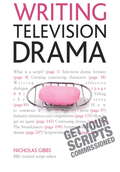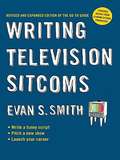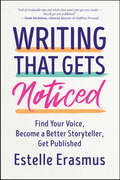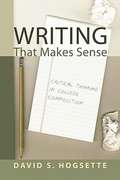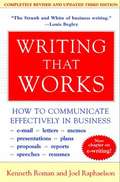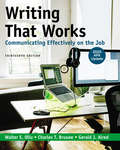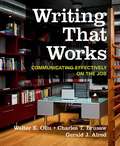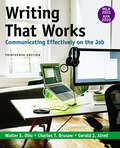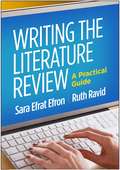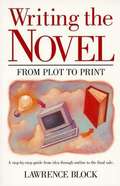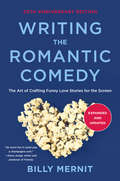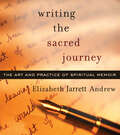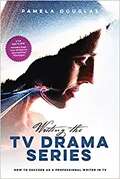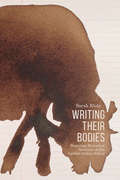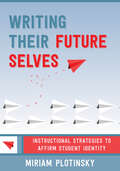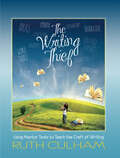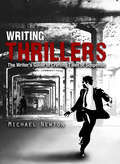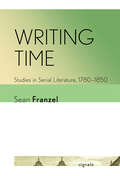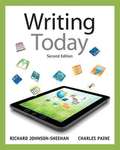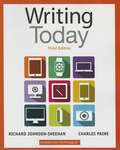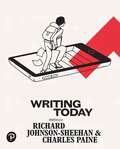- Table View
- List View
Writing Talk: Interviews with Writers about the Creative Process
by Derek NealeWriting Talk includes interviews with nineteen well-known contemporary writers, exploring the ways in which they research and find their original ideas. Working across genres such as fiction, scriptwriting, radio, life writing, biography and more, the writers offer insight into how they interpret, hone and develop these ideas. The conversations examine the roles of technique, craft, language, reading, memory, serendipity, habit and persistence. They offer technical detail about the creative process and give unique insights into the borderlands between genres as well as offering rich, personal insights and universal resonances. A wide-ranging introduction surveys the reasons why we are intrigued by the mysteries of individual writing practice and how these illuminate critical attitudes to literature and performance. Offering a rare glimpse into the creative process of some of this generation’s most eminent voices, Writing Talk is a must read for anyone interested in how stories are found and made. Interviewees: Alan Ayckbourn, Iain Banks, Helen Blakeman, Louis de Bernières, Sarah Butler, Andrew Cowan, Jenny Diski, Patricia Duncker, David Edgar, Tanika Gupta, Richard Holmes, Hanif Kureishi, Bryony Lavery, Toby Litt, Kareem Mortimer, Michèle Roberts, Jane Rogers, Willy Russell and Sally Wainwright.
Writing Tangier in the Postcolonial Transition: Space and Power in Expatriate and North African Literature
by Michael K. WalonenIn his study of the Tangier expatriate community, Michael K. Walonen analyzes the representations of French and Spanish Colonial North Africa by Paul Bowles, Jane Bowles, William Burroughs, Brion Gysin, and Alfred Chester during the end of the colonial era and the earliest days of post-independence. The conceptualizations of space in these authors' descriptions of Tangier, Walonen shows, share common components: an attention to the transformative potential of the conflict sweeping the region; a record of the power relations that divided space along lines of gender and ethnicity, including the spatial impact of the widespread sexual commerce between Westerners and natives; a vision of the Maghreb as a land that can be dominated or imposed on as a kind of frontier space; an expression of anxieties about the specters of Cold War antagonisms; and an embrace of the underlying logic of the market to the culture of the Maghreb. Counterbalancing the depictions of Tangier by Westerners who sought to reconcile their nostalgia for the colonial order with their support of native demands for independent governance is Walonen's extended analysis of the contrasting sense of place found in the writings of native Moroccan authors such as Mohammed Choukri, Tahar Ben Jelloun, and Anouar Majid. In its focus on Tangier and the larger Maghreb as a lived environment situated at a particular spatial and temporal crossroads, Walonen's study makes an important contribution to the fields of urban, transatlantic, and postcolonial studies.
Writing Technology: Studies on the Materiality of Literacy
by Christina HaasAcademic and practitioner journals in fields from electronics to business to language studies, as well as the popular press, have for over a decade been proclaiming the arrival of the "computer revolution" and making far-reaching claims about the impact of computers on modern western culture. Implicit in many arguments about the revolutionary power of computers is the assumption that communication, language, and words are intimately tied to culture -- that the computer's transformation of communication means a transformation, a revolutionizing, of culture. Moving from a vague sense that writing is profoundly different with different material and technological tools to an understanding of how such tools can and will change writing, writers, written forms, and writing's functions is not a simple matter. Further, the question of whether -- and how -- changes in individual writers' experiences with new technologies translate into large-scale, cultural "revolutions" remains unresolved. This book is about the relationship of writing to its technologies. It uses history, theory and empirical research to argue that the effects of computer technologies on literacy are complex, always incomplete, and far from unitary -- despite a great deal of popular and even scholarly discourse about the inevitability of the computer revolution. The author argues that just as computers impact on discourse, discourse itself impacts technology and explains how technology is used in educational settings and beyond. The opening chapters argue that the relationship between writing and the material world is both inextricable and profound. Through writing, the physical, time-and-space world of tools and artifacts is joined to the symbolic world of language. The materiality of writing is both the central fact of literacy and its central puzzle -- a puzzle the author calls "The Technology Question" -- that asks: What does it mean for language to become material? and What is the effect of writing and other material literacy technologies on human thinking and human culture? The author also argues for an interdisciplinary approach to the technology question and lays out some of the tenets and goals of technology studies and its approach to literacy. The central chapters examine the relationship between writing and technology systematically, and take up the challenge of accounting for how writing -- defined as both a cognitive process and a cultural practice -- is tied to the material technologies that support and constrain it. Haas uses a wealth of methodologies including interviews, examination of writers' physical interactions with texts, think-aloud protocols, rhetorical analysis of discourse about technology, quasi-experimental studies of reading and writing, participant-observer studies of technology development, feature analysis of computer systems, and discourse analysis of written artifacts. Taken as a whole, the results of these studies paint a rich picture of material technologies shaping the activity of writing and discourse, in turn, shaping the development and use of technology. The book concludes with a detailed look at the history of literacy technologies and a theoretical exploration of the relationship between material tools and mental activity. The author argues that seeing writing as an embodied practice -- a practice based in culture, in mind, and in body -- can help to answer the "technology question." Indeed, the notion of embodiment can provide a necessary corrective to accounts of writing that emphasize the cultural at the expense of the cognitive, or that focus on writing as only an act of mind. Questions of technology, always and inescapably return to the material, embodied reality of literate practice. Further, because technologies are at once tools for individual use and culturally-constructed systems, the study of technology can provide a fertile site in which to examine the larger issue of the relationship of culture and cognition.
Writing Television Drama: Get Your Scripts Commissioned
by Nicholas GibbsBreak Into Writing For Television takes you from the very first line of the script through to becoming a regular writer for soaps and 'continuing dramas'. It starts with the basics of different types of script and production, and moves on to getting ideas, shaping character and dialogue, re-writing, pitching work and the practicalities of who does what in the production world, in both the UK and the US. Structured around a practical, progressive, goal-orientated approach, each chapter contains a diagnostic test, case studies, practical exercises and Aide Memoire boxes. Each chapter concludes with a reminder of the key points of the chapter (Focus Points) and a round-up of what to expect in the next (Next Step), which will whet your appetite for what's coming and how it relates to what you've just read.
Writing Television Drama: Teach Yourself
by Nicholas GibbsBreak Into Writing For Television takes you from the very first line of the script through to becoming a regular writer for soaps and 'continuing dramas'. It starts with the basics of different types of script and production, and moves on to getting ideas, shaping character and dialogue, re-writing, pitching work and the practicalities of who does what in the production world, in both the UK and the US. Structured around a practical, progressive, goal-orientated approach, each chapter contains a diagnostic test, case studies, practical exercises and Aide Memoire boxes. Each chapter concludes with a reminder of the key points of the chapter (Focus Points) and a round-up of what to expect in the next (Next Step), which will whet your appetite for what's coming and how it relates to what you've just read.
Writing Television Sitcoms (revised)
by Evan S. SmithNew edition of the popular screenwriting guide! Writing Television Sitcoms is the ultimate all-in-one guide to writing a funny script, pitching a new show, and launching a successful career. AS digital technology reshapes the television industry, this new and expanded edition explains how today's writers can get ahead of the curve. Features include: ? A complete description of premise-driven comedy, a proven method for "writing funny from the ground up" ? Numerous examples from new and classic shows ? Advice from top writer-producers ? A thorough look at how sitcom story models are changing ? Complete script layout guidelines for all three formats ? Tips on how new-media developments can help you break into the business
Writing That Gets Noticed: Find Your Voice, Become a Better Storyteller, Get Published
by Estelle ErasmusSelected as one of the Best Books for Writers by Poets & Writers Successful essayist, columnist, writing instructor, and editor Estelle Erasmus will show you how to find your voice, write stellar pieces, and get published. In real-world, experience-based chapters, she coaches you to: • mine your life for ideas and incubate those ideas • choose the perfect format — essay, op-ed, feature article, and more • research publications and follow editor etiquette • craft a perfect pitch • protect your psyche from rejection • revise your work for maximum impact • deliver what you promise, protect your work, and get paid
Writing That Makes Sense: Critical Thinking In College Composition
by David S. HogsetteWriting That Makes Sense takes students through the basics of the writing process and critical thinking, and it teaches them how to write various types of academic essays they are likely to encounter in their academic careers. Drawing on nearly twenty years of experience in teaching college composition and professional writing, David S. Hogsette combines relevant writing pedagogy and practical assignments with the basics of critical thinking and logical thought to provide students with step-by-step guides for successful writing in academia. Writing That Makes Sense includes many professional essays and articles from a variety of voices often underrepresented in academia today, thus introducing students to a wider intellectual diversity. Students will also benefit from a chapter on information literacy that provides practical tips on engaging the research process and writing research papers.
Writing That Works, 3e
by Joel Raphaelson Kenneth RomanWriting That Works will help you say what you want to say, with less difficulty and more confidence. Now in its third edition, this completely updated classic has been expanded to included all new advice on e-mail and the e-writing world, plus a fresh point of view on political correctness. With dozens of examples, many of them new, and useful tips for writing as well as faster on a computer, Writing That Works will show you how to improve anything you write:Presentations that move ideas and actionMemos and letters that get things donePlans and reports that make things happenFund-raising and sales letters that produce resultsResumes and letters that lead to interviewsSpeeches that make a point
Writing That Works: Communicating Effectively On The Job
by Gerald Alred Charles Brusaw Walter OliuWith 2020 APA Update. More than ever, Writing That Works is the right choice for the most up-to-date coverage of business writing. Real-world model documents are grounded in their rhetorical contexts to guide students in navigating the increasingly complex world of business writing. Now in full-color, the thirteenth edition continues to reflect the central role of technology in the office and the classroom, showcasing the most current types of business documents online and in print, providing succinct guidelines on selecting the appropriate medium for your document, communication, or presentation, and featuring new advice on creating a personal brand as part of a successful job search. Also available as an e-book and in loose-leaf, Writing that Works offers robust but accessible coverage at an affordable price.
Writing That Works: Communicating Effectively On The Job
by Gerald J. Alred Charles T. Brusaw Walter E. OliuCountless real-world model documents contextualized by clear rhetorical instruction and a focus on professional ethics make Writing That Works the foundational standard for professional writing. More than ever, this streamlined twelfth edition reflects the role of technology in the office and the classroom, showcasing the most current types of business documents online and in print, providing succinct guidelines on selecting the appropriate medium for your document, communication, or presentation, and giving advice on landing and keeping a job in today’s economy.
Writing That Works: Communicating Effectively on the Job with 2020 APA and 2021 MLA Updates
by Gerald J. Alred Charles T. Brusaw Walter E. OliuThis ebook has been updated to provide you with the latest guidance on documenting sources in MLA style and follows the guidelines set forth in the MLA Handbook, 9th edition (April 2021).More than ever, Writing That Works is the right choice for the most up-to-date coverage of business writing. Real-world model documents are grounded in their rhetorical contexts to guide students in navigating the increasingly complex world of business writing. Now in full-color, the thirteenth edition continues to reflect the central role of technology in the office and the classroom, showcasing the most current types of business documents online and in print, providing succinct guidelines on selecting the appropriate medium for your document, communication, or presentation, and featuring new advice on creating a personal brand as part of a successful job search. Also available as an e-book and in loose-leaf, Writing that Works offers robust but accessible coverage at an affordable price.
Writing The Literature Review: A Practical Guide
by Sara Efrat Efron Ruth RavidThis accessible text provides a roadmap for producing a high-quality literature review--an integral part of a successful thesis, dissertation, term paper, or grant proposal. Each step of searching for, evaluating, analyzing, and synthesizing prior studies is clearly explained and accompanied by user-friendly suggestions, organizational tips, vignettes, and examples of student work. Also featured are excerpts from peer-reviewed quantitative, qualitative, and mixed methods articles. This is the first book to focus on crafting different types of reviews (systematic, traditional–narrative, or hermeneutic–phenomenological) that reflect the writer's research question, methodological choices, and approaches to knowledge. It describes what all reviews have in common and highlights distinct characteristics of each type. The book includes dos and don'ts for evaluating studies and constructing an argument, and software suggestions for locating, organizing, and arranging sources.
Writing The Novel: From Plot To Print
by Lawrence BlockBlock covers every step of the novel writing and selling process to help writers deliver a salable manuscript to the right editor's desk.
Writing The Romantic Comedy, 20th Anniversary Expanded and Updated Edition: The Art of Crafting Funny Love Stories for the Screen
by Billy Mernit“Writing the Romantic Comedy is so much fun to read it could pop a champagne cork.”—Alexa Junge, writer and producer of FriendsRevised and expanded to celebrate a new generation of romantic comedies, Billy Mernit’s insightful look into the mechanics of writing Hollywood’s most enduring genre features case studies that reveal the screenwriting secrets behind classics new and old.Whether you’re a first-time screenwriter, an intermediate marooned in the rewriting process, or a professional wanting to explore the latest genre trends, this thoroughly charming and insightful guide to the basics of crafting a winning and innovative script will take you step by step from “meet cute” all the way to “joyous defeat.” You’ll learn the screenwriting secrets behind some of the funniest scenes ever written; how to create characters and dialogue that getsparks flying; why some bedroom scenes sizzle and others fall flat; and much more. Written in a refreshingly accessible style and updated and expanded to recognize the contributions of a fresh generation of romantic comedies, this newly revised 20th Anniversary edition of Writing the Romantic Comedy features case studies drawn from beloved romantic classics such as When Harry Met Sally, Annie Hall, Tootsie, and The Lady Eve to modern-day favorites including Hitch, (500) Days of Summer, Bridesmaids, and Silver Linings Playbook. Field-tested writing exercises are also included, guaranteed to short-circuit potential mistakes and ensure inspiration.
Writing The Sacred Journey: The Art and Practice of Spiritual Memoir
by Elizabeth Jarrett Andrew“Here is the definitive handbook for those courageous souls taking on the creative and ethical challenge of writing a spiritual memoir.—Frederic and Mary Ann Brussat, Spirituality & Practice In Writing the Sacred Journey, readers will discover how to construct a well-crafted spiritual memoir—one that honors the author's interior, sacred story and is at the same time accessible to others. Award-winning writer and teacher Elizabeth Jarrett Andrew provides practical advice on how to overcome writing obstacles as well as guidance for transforming the writing process into a spiritual practice. A writing instructor and spiritual director, Andrew teaches spiritual memoir at Wisdom Ways Center for Spirituality in St. Paul, Minneapolis.
Writing The TV Drama Series: How To Succeed As A Professional Writer In TV
by Pamela DouglasThis revised and updated edition is a complete resource for anyone who wants to write and produce for television drama series or create an original series, as well as for teachers in screenwriting classes and workshops. It leads the reader step-by-step through every stage of the development and writing process, offering practical industry information and artistic inspiration. The Fourth Edition leads readers into the future and engages provocative issues about the interface between traditional TV and emerging technologies. It’s also the single most comprehensive source on what is happening in original television drama around the world, with surveys of 15 countries.
Writing Their Bodies: Restoring Rhetorical Relations at the Carlisle Indian School
by Sarah KlotzBetween 1879 and 1918, the Carlisle Indian Industrial School housed over 10,000 students and served as a prototype for boarding schools on and off reservations across the continent. Writing Their Bodies analyzes pedagogical philosophies and curricular materials through the perspective of written and visual student texts created during the school’s first three-year term. Using archival and decolonizing methodologies, Sarah Klotz historicizes remedial literacy education and proposes new ways of reading Indigenous rhetorics to expand what we know about the Native American textual tradition. This approach tracks the relationship between curriculum and resistance and enumerates an anti-assimilationist methodology for teachers and scholars of writing in contemporary classrooms. From the Carlisle archive emerges the concept of a rhetoric of relations, a set of Native American communicative practices that circulates in processes of intercultural interpretation and world-making. Klotz explores how embodied and material practices allowed Indigenous rhetors to maintain their cultural identities in the off-reservation boarding school system and critiques the settler fantasy of benevolence that propels assimilationist models of English education. Writing Their Bodies moves beyond language and literacy education where educators standardize and limit their students’ means of communication and describes the extraordinary expressive repositories that Indigenous rhetors draw upon to survive, persist, and build futures in colonial institutions of education.
Writing Their Future Selves: Instructional Strategies to Affirm Student Identity
by Miriam PlotinskyWhatever subject you teach, you can encourage students’ sense of self-worth. “I’m a bad writer” is a disclaimer every secondary teacher has heard many times. Overcoming that negative self-image, Plotinsky argues, is key to helping students build a positive academic identity—and because of the vulnerability associated with sharing what we write, the benefits of interrupting this particular form of deficit thinking extend far beyond English class. Drawing on her years of experience as an English teacher and literacy specialist, Miriam Plotinsky uses writing instruction as a powerful vehicle to examine how teachers can help students build a sense of themselves as legitimate, valuable contributors to the world around them. The chapters move fluidly through ways to build capacity such as celebrating student voice, separating grading from class participation, giving feedback that inspires trust, and avoiding the labeling of students. Along the way, teachers in other content areas contribute insights into how the identity-building strategies in the book can be applied to their own disciplines.
Writing Thief: Using Mentor Texts to Teach the Craft of Writing
by Ruth CulhamMediocre writers borrow. Great writers steal. --T.S. EliotWriting thieves read widely, dive deeply into texts, and steal bits and pieces from great texts as models for their own writing. Author Ruth Culham admits to being a writing thief'sand she wants you and your students to become writing thieves, too! In The Writing Thief: Using Mentor Texts to Teach the Craft of Writing, Culham demonstrates a major part of good writing instruction is finding the right mentor texts to share with students. Within this book, you'll discover more than 90 excellent mentor texts, along with straight-forward activities that incorporate the traits of writing across informational, narrative, and argument modes. Chapters also include brief essays from beloved writing thieves such as Lester Laminack, David L. Harrison, Lisa Yee, Nicola Davies, Ralph Fletcher, Toni Buzzeo, Lola Schaefer, and Kate Messner, detailing the reading that has influenced their own writing. Culham's renowned easy-going style and friendly tone make this a book you'll turn to again and again as you coach your students to reach their full potential as deep, thoughtful readers and great writers. There's a writing thief in each of us when we learn how to read with a writer's eye!
Writing Thrillers: The Writer's Guide to Crafting Tales of Suspense
by Michael NewtonIn this invaluable guide, thriller master Michael Newton shows you how to develop compelling plots and intriguing characters that grab readers from page 1 and won't let them go. You'll learn how to craft heroes and villains that are both believable and original and ground them in situations that push them to the limits of physical, emotional, and mental endurance. You'll also find details that will imbue your thriller with authenticity, from the specifics of using guns and knives to the inner workings of secret government agencies. From global conspiracies and knife-wielding psychopaths to ruthless cults and political schemers, Writing Thrillers will give you the tools you need to keep pulses racing, palms sweating, and readers on the edges of their seats.
Writing Time: Studies in Serial Literature, 1780–1850 (Signale: Modern German Letters, Cultures, and Thought)
by Sean FranzelWriting Time shows how serial literature based in journals and anthologies shaped the awareness of time at a transformative moment in the European literary and political landscapes. Sean Franzel explores how German-speaking authors and editors "write time" both by writing about time and by mapping time itself through specific literary formats.Through case studies of such writers as F. J. Bertuch, K. A. Böttinger, J. W. Goethe, Ludwig Börne, and Heinrich Heine, Franzel analyzes how serial writing predicated on open-ended continuation becomes a privileged mode of social commentary and literary entertainment and provides readers with an ongoing "history" of the present, or Zeitgeschichte. Drawing from media theory and periodical studies as well as from Reinhart Koselleck's work on processes of temporalization and "untimely" models of historical time, Writing Time presents "smaller" literary forms—the urban tableau, cultural reportage, and caricature—as new ways of imagining temporal unfolding, recentering periodicals and other serial forms at the heart of nineteenth-century print culture.
Writing Today
by Richard Johnson-Sheehan Charles PaineWith a clear and easy-to-read presentation, visual instruction and pedagogical support, Writing Today is a practical and useful guide to writing for college and beyond. This text teaches how to transfer their writing skills to careers. By teaching kinds of writing (analyses, reports, proposals, etc. ), strategies for writing (narration, comparison, argumentation, etc. ), and processes for writing (planning, drafting, revising, etc. ), Writing Today provides the writer with tools they can mix and match as needed to respond effectively to many writing situations.
Writing Today
by Richard Johnson-Sheehan Charles PaineAccessible to students and flexible for instructors, Writing Today, Third Edition introduces students to the conventions of writing memoirs, profiles, literary analyses, arguments, research papers, and more. Each chapter features a step-by-step process for composing within a given genre, as well as exemplary student and professional readings to promote rhetorical knowledge and critical analysis. The 42 short chapters, the chunked writing style, and visual instruction work to ensure that students will transfer the skills and strategies practiced in your class to their other classes, their lives, and their careers. From its graphic “Quick Start Guides” to its “Write This” prompts, Writing Today challenges students to extend the boundaries of their writing abilities as they practice composing for the real world.
Writing Today
by Johnson-Sheehan Richard Paine CharlesWriting Today provides you with practical writing skills for composing in the real world. This is an accessible text created with today's students in mind. It's chunked writing style, eye-catching design and focus on writing genres, strategies, and processes sets you up for success. You'll gain knowledge you can utilize in your college courses, your career, and your civic life. The 4th Edition marks a turning point in this highly successful series. Authors Richard Johnson-Sheehan and Charles Paine have made reflection, or discovering why we think the way we do, one of the central concepts of the revision. As you explore this theme, you'll build your intellect, become more aware, versatile, and resilient.
